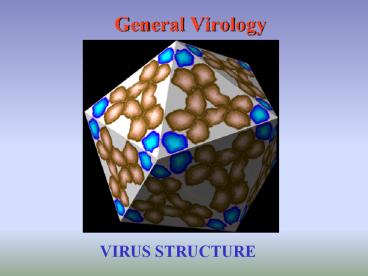General Virology - PowerPoint PPT Presentation
Title:
General Virology
Description:
Helical vs Icosahedral Symmetry - Why do most viruses look alike? ... Viral property that varies depending on the host ... Chemical synthesis of poliovirus: ... – PowerPoint PPT presentation
Number of Views:1753
Avg rating:3.0/5.0
Title: General Virology
1
General Virology
VIRUS STRUCTURE
2
Virion vs virus
- Virion is the infectious particle
- composed of nucleic acid, protein capsid, /-
envelope - may be extracellular or intracellular
- Virus is any stage of infection
3
How do we know that NA is genetic material?
Hershey-Chase
Fraenkel-Conrat Experiment
TRANSFECTION EXPTS
4
TRANSFECTION FAILS FOR SOME VIRUSES
- WHY?
5
Capsid
- Functions
- Protection of NA
- Attachment for naked viruses
- Enzyme
- Helical vs Icosahedral Symmetry - Why do most
viruses look alike? - Tobacco mosaic virus is a ssRNA virus composed of
6000 nucleotides. The capsid is made of 2100
copies of a single protein subunit that contain
158 amino acids. Calculate the percentage of the
genome that is used for structure.
6
How do helical viruses differ?
- Helical- one axis of symmetry down center
- Multiple structural units
7
Icosahedral symmetry
- 20 identical equilateral triangles
- Structural units on faces to give morphological
capsomers - Pentons (5 fold axis of symmetry)
- Hexons
- 3 fold through face
- 2 fold through edge
How do spherical viruses differ?
8
Envelope
- Attachment
- Entry
- Assembly- matrix proteins
- Release
- Proteins are viral
- Lipids are host
- Rare in plants or bacteria - why?
- If the membrane envelope is destroyed, the virus
becomes noninfectious. Why?
9
Herpesvirus complexity
- Tegument proteins - 12/84 viral proteins in HSV
- Potential role?
- Virion mRNA
- DNAase virion nucleic acids
- RT-PCR
- probe genome array
- Potential role?
10
Genome - DNA or RNA
- strandedness - (single) (double)
- linear or circular, partial double stranded
circle - number (single, segmented, multicomponent)
How do we experimentally show that DNA or RNA is
the virus genetic material?
11
RNA Genomes
- sense (positive-sense, negative-sense, ambisense)
- presence or absence of 5'-terminal cap or
5'-covalently-linked protein - presence or absence of 3'-terminal poly (A) tract
- Retroviruses - replication strategy
12
Some viruses have high degree of secondary
structure
- Poliovirus - 5 internal ribosome entry site
(IRES)
Guest et al. 2004. J. Virol. 78 11097.
13
SARS/coronaviruses have conserved 3region
- SARS s2m in red
- a - green 530 loop of 16S RNA
- Similar binding properties
- b - blue S12
- magenta IF1
- Possible role for s2m
- Hijacks protein synthesis from cell(binding cell
factors) - Needed to bind to similar viral protein for
transcription - Potential drug target in red tunnel
Robertson et al. 2005. PLOsBiology3.
14
DNA Viruses may be large genomes
- PolyDNAvirus (PDV) - contain many DNA segments
- Mimivirus - larger than small bacteria
15
Host-induced modification
- Viral property that varies depending on the host
- Phage DNA hydroxymethyl cytosine (HMC) replaces C
- Viral enzymes C to HMC
- Viral DNA polymerase adds HMC not C
- What is advantage of HMC?
- Glucose is attached to HMC
- Host enzyme needed to prepare glucose
- Protects against host nuclease
16
- What would happen if virus without glucose enters
host with RE? - What would happen if virus with glucose enters
host w/o enzyme to create UDP- glucose?
Host enzyme makes
17
Proteins
- structural proteins
- non-structural virion proteins
- transcriptase,
- protease
- integrase
18
How to identify virion proteins
- Purify KSHV virions
- Run on SDS PAGE
- Excise bands, digest - get sequence and compare
to database
19
Chemical synthesis of poliovirus What are the
implications?
- Small genome positive strand RNA - sequence known
- Synthesized small DNA segments ( 69 nucleotides)
with overlapping complementary segments - Added a T7 phage promotor to DNA
- Used DNA to make genome RNA in HeLa cell lysate
with T7 polymerase - Results How do you show success?
20
(No Transcript)
21
(No Transcript)
22
International Congress on Taxonomy of Viruses
http//www.ncbi.nlm.nih.gov/ICTV/
- Morphology
- virion size
- enveloped or naked nucleocapsid
- capsid symmetry and structure
- Genome characteristics
- Replication strategy
- Antigenic Properties
23
Baltimore classification
24
WHY TRANSFECTION FAILS
25
ONE STEP GROWTH CURVE
- 1939- Ellis and Delbruck
- Infection with a high multiplicity of infection
(MOI) ratio of virus to host cell - Simultaneous infection
- Single replication cycle
- Sample at time intervals by plaque count for
plaque-forming units (PFU), - Identification of latent phase
- Determination of burst size/viral yield
26
Measuring Intracellular Events
- Sample at time intervals after lysing cells (1952
- Doermann) - Chloroform
- Lysis from without
- Identification of eclipse and maturation phases
Maturation phase
27
(No Transcript)
28
- Strategy of replication
- Lytic
- Temperate
29
Biologic Properties
- natural host range
- mode of transmission in nature
- vector relationships
- geographic distribution
- pathogenicity, association with disease
- tissue tropisms, pathology, histopathology
30
How can you identify these viruses?

